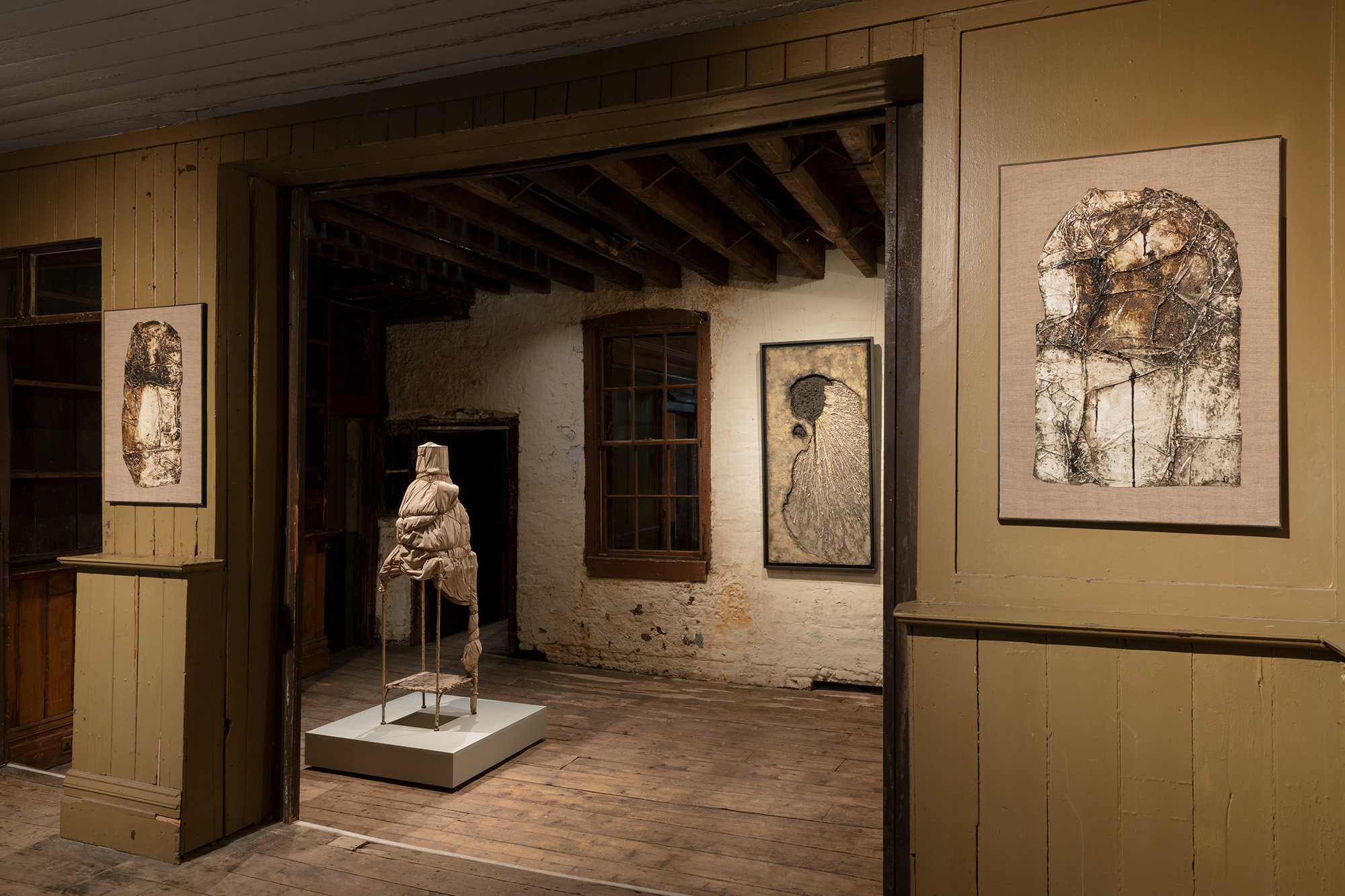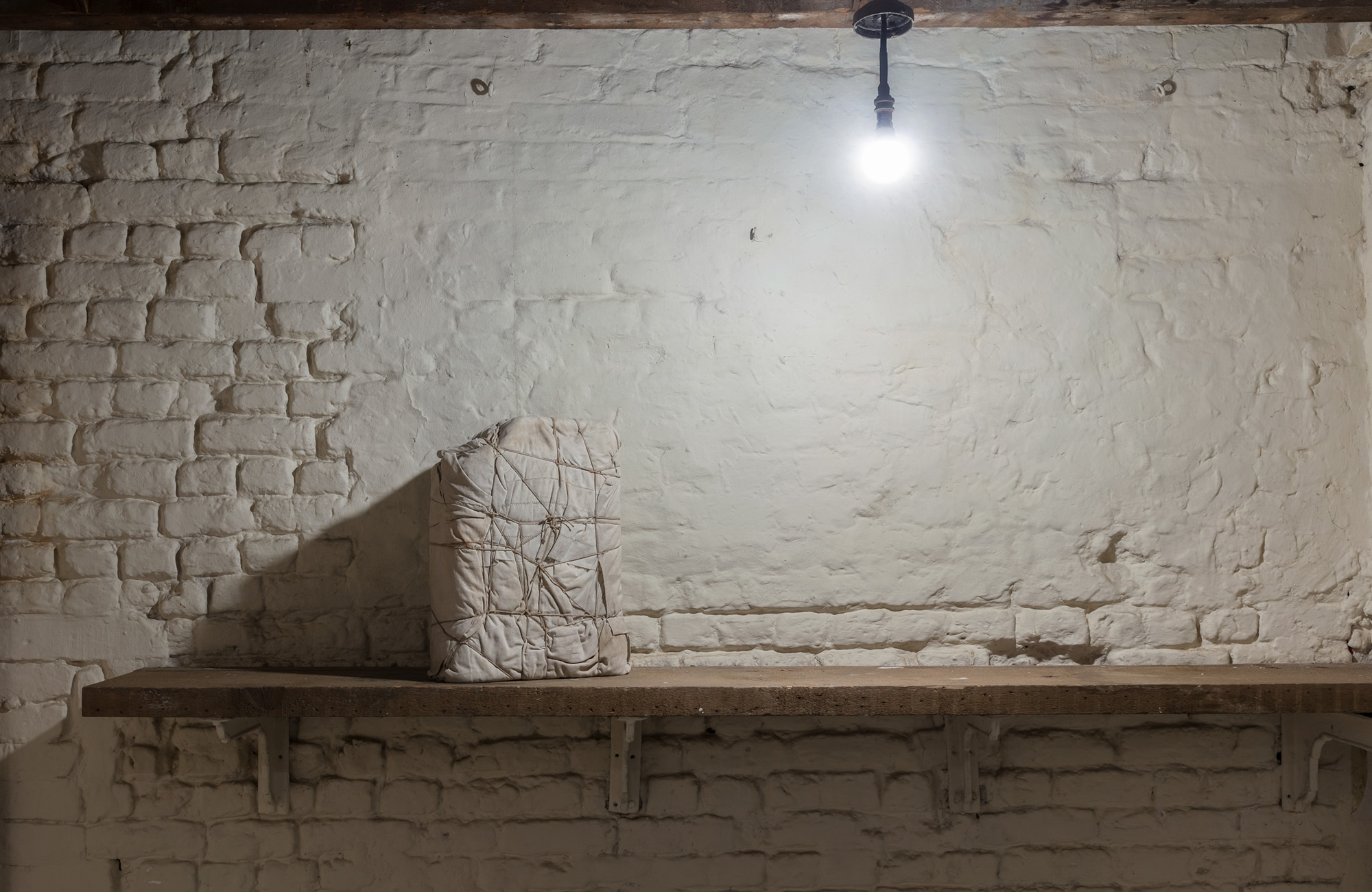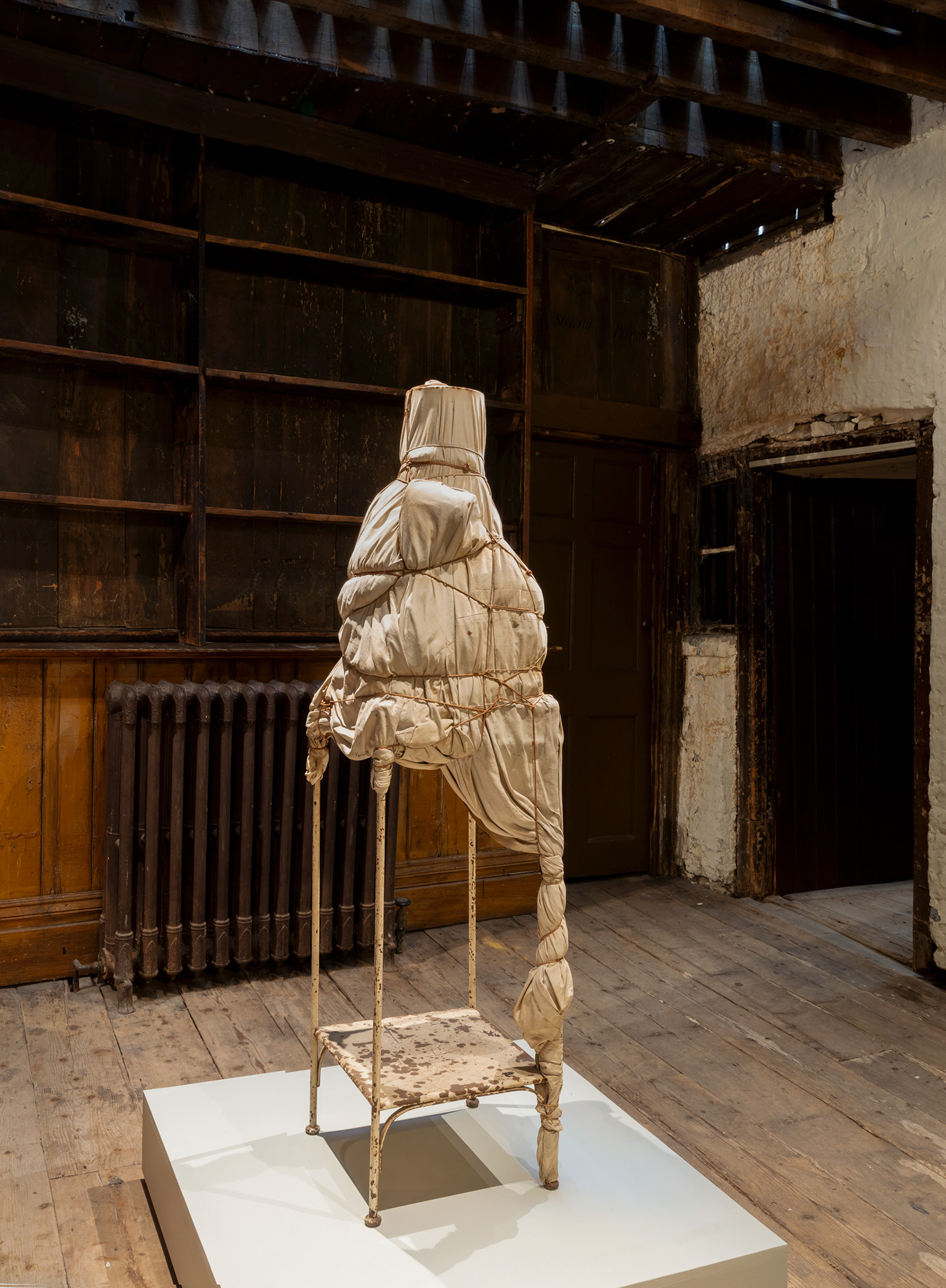Christo wrappings within a Georgian townhouse: an
interview with curator Elena Geuna
A Georgian house in East London temporarily becomes a gallery dedicated
to the earliest works of celebrated artist Christo. Where he is most well known
for his large-scale architectural wrappings and landscape works, this show, part
of the new Gagosian Open programme, offers a more domestic and delicate scale
to the artist’s practice. Will Jennings discussed the exhibition and architecture
with curator Elena Geuna.
Gagosian Open is a new programme from the international gallery which will install ambition temporary projects outside of the gallery setting, into unusual architectural spaces and contexts, including in cities not currently home to a Gagosian gallery.
The programme launches with an exhibition in London’s Spitalfields, within a Grade II listed Georgian house on Princelet Street, coinciding with Frieze London art fair. Inside the early works of Christo are presented atmospherically across four floors, delicate and every day domestic objects from the start of a lifetime of wrapping which, with his wife Jeanne-Claude, went on to include monumental-scale projects including the Reichstag and the Arc de Triomphe.
recessed.space spoke to the curator of the exhibition, Elena Geuna, to explore the works within 4 Princelet Street, what we can learn from the exhibition, and how a curator works with such unique architectural settings:

Fig.i
recessed.space: As a sneak preview of the exhibition, what can visitors expect? And how does this differ from a conventional exhibition in a Gagosian white-cube gallery?
Elena Geuna: Exhibitions are always a dialogue with the space they are within. This is a wonderful Georgian house with its architecture presented as it was, and not contemporarily restored, so a dialogue is established between not only the architecture of the house, but the local area. Spitalfields was an area of immigration in the 17th and 18th century, and it's always been a place where people come and with generations settling and then moving on – the most recent being the Bangladeshi community. Christo was always a stateless artist. He's moved from Bulgaria to Austria, and then with a very complicated escape eventually made it to Paris in 1958, then to New York in 1964. He always felt that even though he lived in New York for such a long time, and had American citizenship, he still felt a foreigner.
So, we have a perfect dialogue between a very innovative artist and interior domestic architecture, and the works of Christo in a way seem to have been made for this wonderful house. The dialogue we have tried to establish from the ground floor all the way to the top is one of a story … one of a very innovative artist who has used simple objects that could be found in any home: the shoes of his wife and a friend, a toy tram belonging to his son, a pram, and a table.

Fig.ii
recessed.space: These are very domestic objects, though most people will be more familiar with Christo’s monumental works wrapping whole buildings, alongside the preparatory drawings and sketches. Are these works people may not have seen before?
Elena Geuna: I think it will be a great discovery. I've been aware of these works for a long time … and I've always found them fascinating and innovative if put in the context of his contemporaries in Paris and New York in the early 1960s. In 2020 there was a beautiful Christo exhibition at the Centre Pompidou in Paris where a few of these works were on display in parallel with his wrapping of the L'Arc de Triomphe [which was delayed until 2021]. The beginning of the exhibition mostly focused on these works, but in London to my knowledge they have never been shown.
The other difference is that Christo’s well known large works – L'Arc de Triomphe, Wrapped (2021), The London Mastaba (2018) in Hyde Park, or The Gates (2005) in Central Park – are usually in public spaces, or that can be seen from the public realm. This is interior domestic and a completely different scale, bringing a very different quality to both the curation and reading.
It does bring different qualities, but for Christo it all departs from here. The domestic, as well as ideas of an urban relationship, wrapping and concealing, are ideas that were there from the beginning, but Christo started to move into larger scale projects as soon as he could. He created these works in the late 1950s, early 1960s, when he was very young and when, especially when living in Paris, his needs were very, very low. So the objects are picked up from friends and family, things which are very intimate in themselves, but then there’s the act of concealment and his interest in altering their contour and surfaces, playing with the form and texture to both reveal and conceal the actual identity of the original objects. In a way, it's a dialogue with an unconscious – that of both the house, and of the artist.

Fig.iii
Christo referred to himself as l’étranger (The Foreigner /The Outsider) because of his movement and migration. This speaks to the migratory history of the area, and Christo’s own story of travelling between places, but I was also thinking about this in relation to houses around Spitalfields, which give so much character and identity to the locality but also act as façades and surfaces which conceal everything within – not only hiding an interior architecture, but also diverse histories and people’s stories.
L’étranger referred to the famous novel by Camus, and even though he spoke perfect French Jeanne-Claude (his wife and creative partner) was French, and his English was impeccable, he still always devoted time to projects in new place, always discovering ideas of movement and relocation. In these works, he's wrapping something and while he’s interested in the form and texture, he's leaving our unconscious to think about what's inside, you will never find out what is inside, we can only imagine. That's what's so fascinating about his early works, how they really ask the imagination of the viewer to develop a relationship and discourse.
You have curated in many gallery settings, but also domestic spaces – including some Palazzi, such as Palazzo Ducale in Genoa where you curated a Lucio Fontana exhibition in 2008 and Palazzo Grassi in Venice where you have curated many times, including shows on Damien Hirst and Sigmar Polke. How do you approach such curation differently to a gallery?
I learned many years ago that the space is the most important thing. You need to walk through the space to understand the architecture and how to create a dialogue. For example, you mention Palazzo Ducale – when I visited it, there were many fake walls [which we removed] to reveal the architecture and create a dialogue between Fontana's work and the 17th and 18th century palazzo. It's very important each time to establish a dialogue with the architecture and then work one room to the next and create a narrative – like creating a musical score, the rhythm of a show has to tell a story visually people can relate to as they pass through.
The better the works are in dialogue with the architecture, the better the exhibition. For example, in this exhibition I wanted a crescendo. As you walk into the ground floor, you are welcomed by a pram, with this idea of transience, movement, and migration. Then you're in dialogue with the next room and one of the major works of the show, the package on a table from 1961. Colour matters and context matters.

Fig.iv
On the first floor, we have a study with one of the very early packages and as you move to the second floor, the personal apartment, it becomes more intimate – in the bedroom you will find the shoes of Jeanne-Claude, the first time they've been presented. On the walls, as if it was a bedroom, you find a wonderful wrapped painting made in Venice in 1963. The bathroom next door has, as if they've always been there, bottles on a shelf. On the top floor, the attic, people might go to as a space to read, think and be away from noise – so I thought it would be a very nice idea to have newspapers and magazines.
I want to touch on an interdisciplinary approach. Your approach pulls together place, context, history, and art objects, while Christo studied a degree which involved painting, sculpture, architecture, and art. Most creative subjects are now taught as a single discipline, so do you think there's something we can learn from such an interdisciplinary approach, and how it can benefit reading and making?
Yes. I learned this working in the world of art, but I have always been interested in art. As a young child, my father used to take me to churches, to museums, to exhibitions. He wanted to be a painter himself, but unfortunately was not allowed – being Italian, art is not a profession but a personal passion that might develop into a profession later in life, which is what happened to me. But I was taught that art is a multi-disciplinary. In Italy, we are surrounded by beautiful buildings – I grew up in Milan, travelled around, to Naples, Turin, and France, and this is part of the context for the art.
As I've learned, working with great artists, you look at the context, you look at the art, you think of the past, and you pull it all together to create a dialogue, because how can you compartmentalise? We are exposed to architecture at the same time we are exposed to paintings and sculpture, and painting and sculpture convey different messages when in different settings. Which is why this Christo exhibition is such a perfect combination, having these works in this architecture.

Fig.v
Elena Geuna is an independent curator, author, and art advisor. Curatorial projects include Fontana: Luce e Colore, Palazzo Ducale, Genoa, Italy (2008); Arte Povera in Moscow, Multimedia Art Museum,
Moscow (2011); Freedom Not Genius: Works from Damien Hirst’s Murderme Collection, Pinacoteca
Agnelli, Turin, Italy (2012–13; traveled to Multimedia Art Museum, Moscow, 2013–14); Rudolf Stingel,
Palazzo Grassi, Venice (2013); Sigmar Polke, Palazzo Grassi, Venice (2016); Damien Hirst: Treasures from the Wreck of the Unbelievable, Palazzo Grassi and Punta della Dogana, Venice (2017); and Lucio
Fontana: Retrospective, Multimedia Art Museum, Moscow (2019–20). She cocurated Jeff Koons, Museo Archeologico Nazionale, Naples, Italy (2003); Jeff Koons: Versailles, Château de Versailles, France
(2008); and Jeff Koons Mucem. Works from the Pinault Collection, Musée des civilisations de l’Europe et
de la Méditerranée, Marseille, France (2021).
Christo and Jeanne-Claude were born on the same day: June 13, 1935; he in Gabrovo, Bulgaria, and
she in Casablanca, Morocco. Jeanne-Claude passed away in 2009, and Christo died in 2020, both
in New York City, where they had moved in 1964. Christo and Jeanne-Claude realized monumental
projects around the world, including Wrapped Coast, One Million Square Feet, Little Bay, Sydney, 1968–69; Running Fence, Sonoma and Marin Counties, California, 1972–76; Surrounded Islands, Biscayne Bay, Greater Miami, Florida, 1980–83; The Pont Neuf Wrapped, Paris, 1975–85; The Umbrellas, Japan–USA,
1984–91; Wrapped Reichstag, Berlin, 1971–95; The Gates, Central Park, New York City, 1979–2005; The
Floating Piers, Lake Iseo, Italy, 2014–16; The London Mastaba, Serpentine Lake, Hyde Park, 2016–18;
and L’Arc de Triomphe, Wrapped, Paris, 1961–2021.
Christo and Jeanne-Claude worked together since their first outdoor temporary work of art: Stacked
Oil Barrels and Dockside Packages, Cologne Harbor, Germany, 1961. Before he escaped to the West,
Christo studied painting, sculpture, architecture, and decorative arts at the National Academy of
Art in Sofia for four years. All early series, such as Wrapped Cans, Wrapped Oil Barrels, Packages, Wrapped Objects, and Store Fronts, as well as all preparatory drawings, collages, and scale models are
works by Christo only. All public projects and indoor installations, both realized and unrealised, are
collaborative works by Christo and Jeanne-Claude.
www.christojeanneclaude.net
About 4 Princelet Street As London’s population grew in the early eighteenth century, housing development on what was then
the city’s fringe gathered pace. The houses on Princelet Street were home to working Londoners and
migrants, particularly the Huguenots, who had been fleeing religious persecution in France since the1680s and brought industrialized silk-weaving to the neighborhood. Completed in 1723, 4 Princelet
Street was originally home to Sir Benjamin Truman, who was attracted by the building’s proximity to
his family’s brewery. By the 1840s, the area was in decline and the house became multiple-occupancy
for the remainder of the century. Subsequently, Spitalfields became home to significant Jewish and
then Bangladeshi communities.
The terraced house at 4 Princelet Street is a double-fronted, three-story construction with a roof loft, its upper levels featuring the original yellow brick. A rear extension was likely added in the 1800s by
silk weavers who lived and worked in the same building and made use of the loft space to optimise
available daylight. The building was Grade II listed by Historic England in 1969, with the houses of
Spitalfields being designated a Conservation Area in 1976.
www.trumanbrewery.com/number4princeletstreet
Gagosian Open is a new programme of ambitious temporary projects sited beyond the walls of the gallerythat allows audiences to experience remarkable artworks in unusual contexts. For the first presentation
in the series, early works by Christo will be set in dialogue with a Grade II–listed Georgian house in
London’s East End. Foreshadowing the artist’s large-scale temporary public projects, these sculptural
works see everyday objects veiled in fabric or plastic and bound with rope or twine. They present an
artist who, even at this formative stage of his career, was responding creatively to domestic and urban environments, drawing attention to overlooked details by obscuring them from view.
www.gagosian.com
Will Jennings is a London based writer, visual artist, and educator interested in cities, architecture, and culture. He has written for the RIBA Journal, the Journal of Civic Architecture, Quietus, The Wire, the Guardian, and Icon. He teaches history and theory at UCL Bartlett and Greenwich University, and is director of UK cultural charity Hypha Studios.
www.willjennings.info
Christo and Jeanne-Claude worked together since their first outdoor temporary work of art: Stacked Oil Barrels and Dockside Packages, Cologne Harbor, Germany, 1961. Before he escaped to the West, Christo studied painting, sculpture, architecture, and decorative arts at the National Academy of Art in Sofia for four years. All early series, such as Wrapped Cans, Wrapped Oil Barrels, Packages, Wrapped Objects, and Store Fronts, as well as all preparatory drawings, collages, and scale models are works by Christo only. All public projects and indoor installations, both realized and unrealised, are collaborative works by Christo and Jeanne-Claude.
www.christojeanneclaude.net
About 4 Princelet Street As London’s population grew in the early eighteenth century, housing development on what was then the city’s fringe gathered pace. The houses on Princelet Street were home to working Londoners and migrants, particularly the Huguenots, who had been fleeing religious persecution in France since the1680s and brought industrialized silk-weaving to the neighborhood. Completed in 1723, 4 Princelet Street was originally home to Sir Benjamin Truman, who was attracted by the building’s proximity to his family’s brewery. By the 1840s, the area was in decline and the house became multiple-occupancy for the remainder of the century. Subsequently, Spitalfields became home to significant Jewish and then Bangladeshi communities.
The terraced house at 4 Princelet Street is a double-fronted, three-story construction with a roof loft, its upper levels featuring the original yellow brick. A rear extension was likely added in the 1800s by silk weavers who lived and worked in the same building and made use of the loft space to optimise available daylight. The building was Grade II listed by Historic England in 1969, with the houses of Spitalfields being designated a Conservation Area in 1976.
www.trumanbrewery.com/number4princeletstreet
Gagosian Open is a new programme of ambitious temporary projects sited beyond the walls of the gallerythat allows audiences to experience remarkable artworks in unusual contexts. For the first presentation in the series, early works by Christo will be set in dialogue with a Grade II–listed Georgian house in London’s East End. Foreshadowing the artist’s large-scale temporary public projects, these sculptural works see everyday objects veiled in fabric or plastic and bound with rope or twine. They present an artist who, even at this formative stage of his career, was responding creatively to domestic and urban environments, drawing attention to overlooked details by obscuring them from view.
www.gagosian.com
Will Jennings is a London based writer, visual artist, and educator interested in cities, architecture, and culture. He has written for the RIBA Journal, the Journal of Civic Architecture, Quietus, The Wire, the Guardian, and Icon. He teaches history and theory at UCL Bartlett and Greenwich University, and is director of UK cultural charity Hypha Studios.
www.willjennings.info
visit
Christo Early Works | Curated by Elena Geuna can be visited at 4 Princelet Street, London, October 6-22. Further information available at:
www.gagosian.com/exhibitions/2023/christo-early-works-curated-by-elena-geuna
images
fig.i
Exterior view, 4 Princelet Street, London E1 6QH. Photo
©
Lucy Dawkins.
Courtesy Gagosian.
figs.ii-v
Christo: Early Works; curated by Elena Geuna (2023). Artwork © Christo and Jeanne-Claude Foundation.
Photo
©
Lucy Dawkins. Courtesy Gagosian.
publication date
06 October 2023
tags
Camus, Centre Pompidou, Christo, Domestic, Christo, Conceal, Exhibition, Jeanne-Claude, Frieze London, Lucio Fontana, Gagosian, Gagosian Open, Georgian, Elena Geuna, Immigration, Will Jennings, London, Monumental, Scale, Sculpture, Spitalfields, Stranger, Travel, Unconscious, Wrapping
www.gagosian.com/exhibitions/2023/christo-early-works-curated-by-elena-geuna


